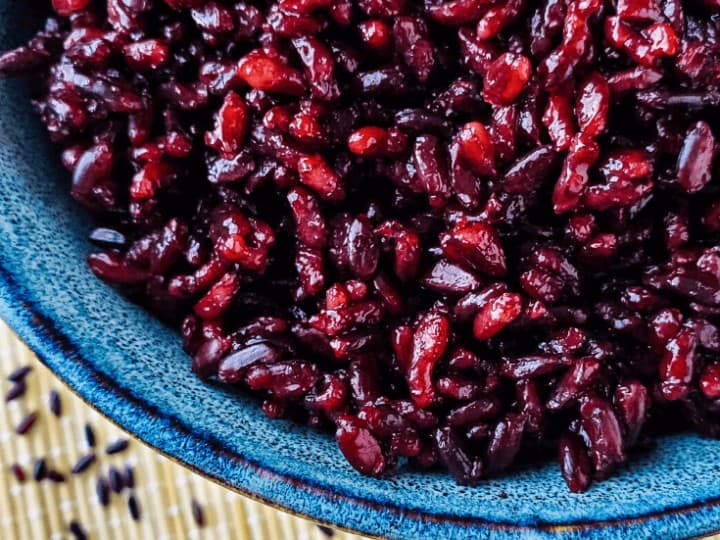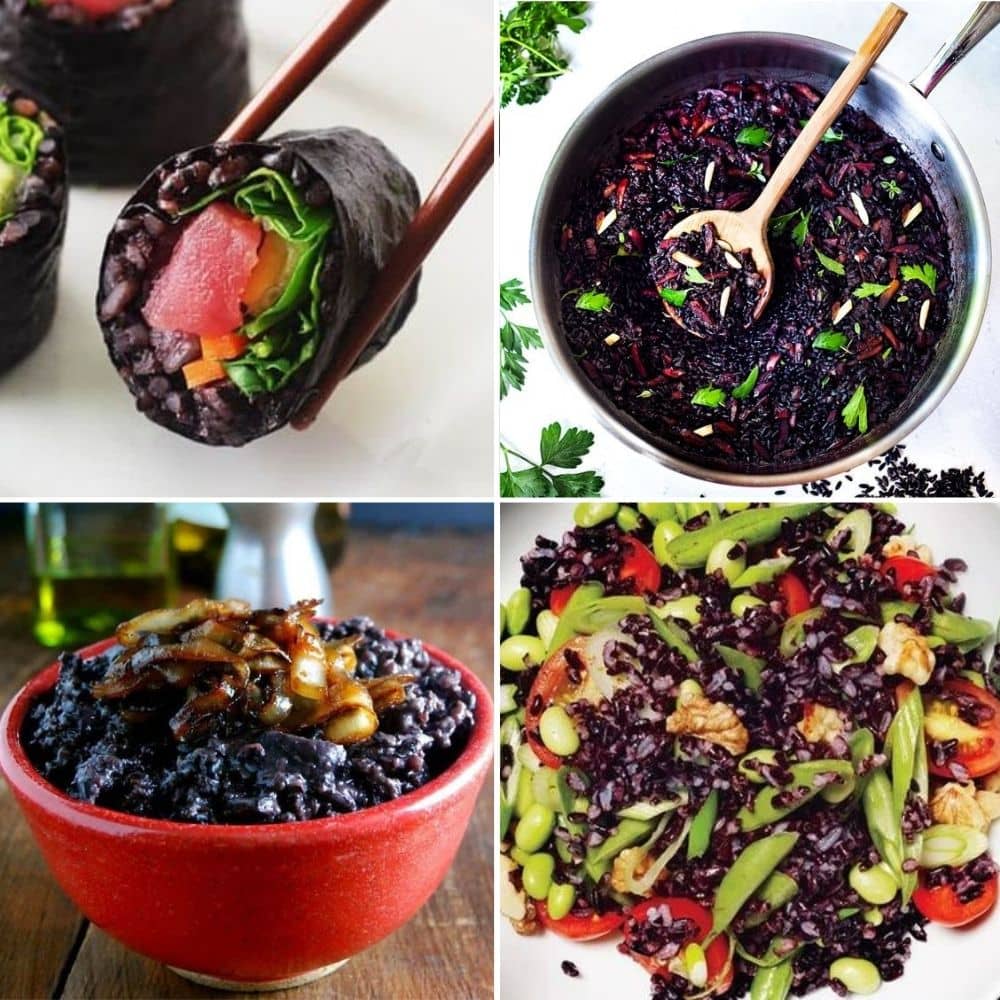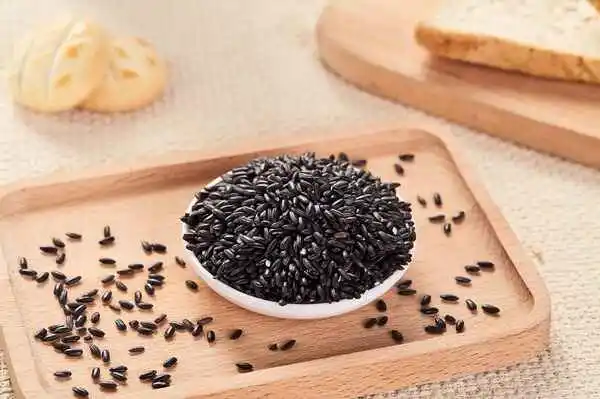Imagine a food that not only satisfies your hunger but also fights against chronic diseases, improves your heart health, and even helps you maintain a healthy weight. That’s the power of black rice. But with so many “superfoods” on the market, you might be wondering: Is black rice really worth the hype?
In this article, we’ll dive deep into the fascinating world of black rice. We’ll explore its rich nutritional profile, uncover its impressive health benefits, see how it stacks up against other rice varieties, and share delicious ways to incorporate this royal grain into your daily diet. Get ready to discover why black rice might just be the missing piece in your nutritional puzzle!
Rich in antioxidants
Black rice, also known as forbidden rice or purple rice, is a nutritional powerhouse packed with antioxidants. The deep purple-black color of this grain is due to its high concentration of anthocyanins, powerful antioxidants that give many dark-colored fruits and vegetables their vibrant hues. These antioxidants play a crucial role in protecting our bodies against oxidative stress and inflammation.
| Antioxidant Content | Black Rice | Brown Rice | White Rice |
|---|---|---|---|
| Anthocyanins | High | Low | None |
| Vitamin E | Moderate | Moderate | Low |
| Flavonoids | High | Moderate | Low |
The antioxidant content in black rice is significantly higher than in other rice varieties, making it an excellent choice for those looking to boost their antioxidant intake through diet.
High fiber content
Another notable feature of black rice is its high fiber content. Fiber is essential for maintaining digestive health, promoting feelings of fullness, and regulating blood sugar levels. A single serving of black rice provides a substantial amount of dietary fiber, contributing to your daily recommended intake.
Benefits of high fiber content in black rice:
Improved digestion and gut health
Better weight management
Reduced risk of heart disease
Stabilized blood sugar levels
Protein-packed grain
Black rice stands out among other rice varieties for its higher protein content. This makes it an excellent choice for vegetarians, vegans, or anyone looking to increase their protein intake from plant-based sources.
Low in calories
Despite its nutrient density, black rice is relatively low in calories, making it an ideal food for those watching their calorie intake or trying to lose weight. It provides a satisfying and nutritious meal without excess calories, helping to maintain a balanced diet.
| Nutrient (per 100g cooked) | Black Rice | White Rice |
|---|---|---|
| Calories | 130 | 160 |
| Protein | 4g | 3g |
| Fiber | 2.5g | 0.4g |
| Antioxidants | High | Low |
The nutritional profile of black rice makes it a superior choice compared to white rice, offering more nutrients and health benefits with fewer calories. Its unique combination of antioxidants, fiber, protein, and low-calorie content contributes to its growing popularity as a superfood.
Now that we’ve explored the impressive nutritional profile of black rice, let’s delve into the specific health benefits these nutrients provide.
Read: Importance of Fiber: The Key to a Healthy Diet | Foods Rich in Fiber!
Health Benefits of Black Rice

Supports heart health
Black rice is a heart-healthy powerhouse, packed with antioxidants that contribute to cardiovascular well-being. The high anthocyanin content in black rice helps reduce inflammation and oxidative stress, two key factors in heart disease. These antioxidants also aid in lowering LDL cholesterol levels, often referred to as “bad” cholesterol, while potentially increasing HDL or “good” cholesterol.
Additionally, black rice is an excellent source of fiber, which plays a crucial role in maintaining heart health. The fiber content helps regulate blood pressure and reduces the risk of heart disease and stroke.
Aids in weight management
For those looking to manage their weight, black rice can be an excellent addition to a balanced diet. Its high fiber content promotes feelings of fullness and satiety, potentially reducing overall calorie intake. Moreover, black rice has a lower glycemic index compared to white rice, which means it causes a slower and more gradual rise in blood sugar levels.
| Nutrient | Black Rice (per 100g) | White Rice (per 100g) |
|---|---|---|
| Fiber | 3.5g | 0.6g |
| Protein | 8.5g | 6.8g |
| Calories | 356 | 365 |
As shown in the table above, black rice offers more fiber and protein while containing fewer calories than white rice, making it a superior choice for weight management.
Improves digestive health
The fiber content in black rice not only aids in weight management but also promotes digestive health. It helps prevent constipation, promotes regular bowel movements, and supports the growth of beneficial gut bacteria. These bacteria play a crucial role in overall digestive health and can even influence immune function and mental health.
Potential anti-cancer properties
Black rice contains impressive levels of antioxidants, particularly anthocyanins, which have been associated with potential anti-cancer properties. These compounds help protect cells from damage caused by free radicals, which can lead to the development of cancer. While more research is needed, early studies suggest that the antioxidants in black rice may help inhibit the growth of cancer cells and reduce inflammation associated with cancer development.
Helps manage diabetes
For individuals with diabetes or those at risk of developing the condition, black rice can be a beneficial dietary choice. Its low glycemic index helps prevent rapid spikes in blood sugar levels, making it easier to manage blood glucose. The fiber content also plays a role in slowing down the absorption of sugars, further contributing to better blood sugar control.
Key benefits for diabetes management include:
Slower release of glucose into the bloodstream
Improved insulin sensitivity
Better long-term blood sugar control
Reduced risk of diabetes-related complications
Now that we’ve explored the numerous health benefits of black rice, let’s compare it with other rice varieties to understand why it stands out as a nutritional powerhouse.
Comparison with Other Rice Varieties
A. Nutritional advantages over white rice
Black rice stands out significantly when compared to its more common counterpart, white rice. The nutritional profile of black rice is substantially richer, offering a wide array of health benefits. Let’s break down the key advantages:
| Nutrient | Black Rice | White Rice |
|---|---|---|
| Fiber | 3x more | Low |
| Protein | Higher | Lower |
| Antioxidants | Abundant | Minimal |
| Vitamins | Rich in B & E | Minimal |
| Minerals | High in iron | Mostly stripped |
Black rice is a powerhouse of nutrients, particularly in its antioxidant content. The deep black-purple color comes from anthocyanins, potent antioxidants that help combat oxidative stress and inflammation in the body. White rice, on the other hand, has been stripped of its bran layer, where most nutrients reside, leaving it with significantly less nutritional value.
B. Differences from brown rice
While both black and brown rice are considered whole grains, black rice edges out brown rice in several aspects:
Antioxidant content: Black rice contains significantly more anthocyanins.
Protein content: Black rice typically has a higher protein content.
Fiber: Both are high in fiber, but black rice often contains slightly more.
Flavor profile: Black rice has a nuttier, more complex flavor.
Cooking time: Black rice generally takes longer to cook than brown rice.
Despite these differences, both black and brown rice are nutritionally superior to white rice and make excellent choices for a healthy diet.
C. Unique benefits compared to red rice
Red rice, another nutritious variety, shares some similarities with black rice but also has distinct differences:
Antioxidant profile: While both contain anthocyanins, black rice has a higher concentration, particularly of the type found in blueberries.
Iron content: Black rice typically contains more iron than red rice.
Texture: Black rice tends to have a slightly firmer texture when cooked.
Versatility in cooking: Black rice’s unique color makes it stand out in various dishes, offering both nutritional and aesthetic benefits.
Both black and red rice are excellent choices for those looking to diversify their grain intake and boost their nutritional profile. However, black rice’s higher antioxidant content and unique color make it a standout option for those seeking maximum nutritional benefit and visual appeal in their meals.
Now that we’ve explored how black rice compares to other rice varieties, let’s look at practical ways to incorporate this nutritional powerhouse into your daily diet.
How to Incorporate Black Rice into Your Diet

Simple cooking methods
Black rice, also known as forbidden rice, can be easily incorporated into your diet using various cooking methods. Here are some simple techniques to prepare this nutritious grain:
Stovetop method:
Rinse 1 cup of black rice thoroughly
Add 2 cups of water or broth
Bring to a boil, then reduce heat and simmer for 30-35 minutes
Let it rest for 10 minutes before fluffing with a fork
Rice cooker method:
Rinse 1 cup of black rice
Add to rice cooker with 1.5 cups of water
Select the brown rice setting and let it cook
Pressure cooker method:
Rinse 1 cup of black rice
Add to pressure cooker with 1.25 cups of water
Cook on high pressure for 18-20 minutes
Allow natural pressure release for 10 minutes
| Cooking Method | Water Ratio | Cooking Time | Yield |
|---|---|---|---|
| Stovetop | 1:2 | 30-35 min | 3 cups |
| Rice Cooker | 1:1.5 | Varies | 3 cups |
| Pressure Cooker | 1:1.25 | 18-20 min | 3 cups |
Black rice recipes
Now that you know how to cook black rice, let’s explore some delicious recipes to showcase its unique flavor and texture:
Black Rice Salad with Mango and Avocado:
Combine cooked black rice with diced mango, avocado, and red bell pepper
Dress with lime juice, olive oil, and cilantro
Black Rice Sushi Rolls:
Use cooked black rice instead of white rice for a nutritious twist on sushi
Fill with your favorite vegetables and seafood
Black Rice Pudding:
Cook black rice with coconut milk and sweeten with honey
Top with fresh fruits and nuts for a healthy dessert
Pairing suggestions
Black rice’s nutty flavor and chewy texture make it an excellent companion to various ingredients:
Proteins: Grilled fish, roasted chicken, or tofu
Vegetables: Roasted sweet potatoes, sautéed mushrooms, or steamed broccoli
Sauces: Coconut curry, teriyaki, or lemon-herb dressing
Fruits: Mango, pomegranate, or citrus fruits for a sweet-savory contrast
Recommended serving size
To reap the benefits of black rice without overindulging, consider these serving size recommendations:
As a side dish: 1/2 to 3/4 cup cooked black rice per person
In salads or main dishes: 1 cup cooked black rice per person
For weight management: Limit to 1/2 cup cooked black rice per meal
Remember that these serving sizes are general guidelines. Individual needs may vary based on factors such as age, gender, activity level, and overall health goals. It’s always best to consult with a nutritionist or dietitian for personalized recommendations.
By incorporating black rice into your diet using these methods, recipes, and serving suggestions, you can enjoy its numerous health benefits while adding variety to your meals. Next, we’ll explore how black rice compares to other rice varieties in terms of nutritional value and health benefits.
Black rice stands out as a nutritional powerhouse, offering a remarkable array of health benefits. Packed with antioxidants, fiber, and essential nutrients, this ancient grain surpasses its white and brown counterparts in nutritional value. From supporting heart health to potentially reducing the risk of chronic diseases, black rice proves to be a valuable addition to any diet.
Incorporating black rice into your meals is both easy and delicious. Whether as a side dish, in salads, or even in desserts, this versatile grain can elevate your culinary experiences while boosting your overall health. Consider swapping your usual rice variety for black rice and unlock its numerous benefits for a healthier, more vibrant you.



:max_bytes(150000):strip_icc()/GettyImages-1475232928-782306100d2a49779e25e22837d9f105.jpg)
:max_bytes(150000):strip_icc()/TypesofRice-eeaaf0ec50114a2cb967772bb0f19e20.jpg)